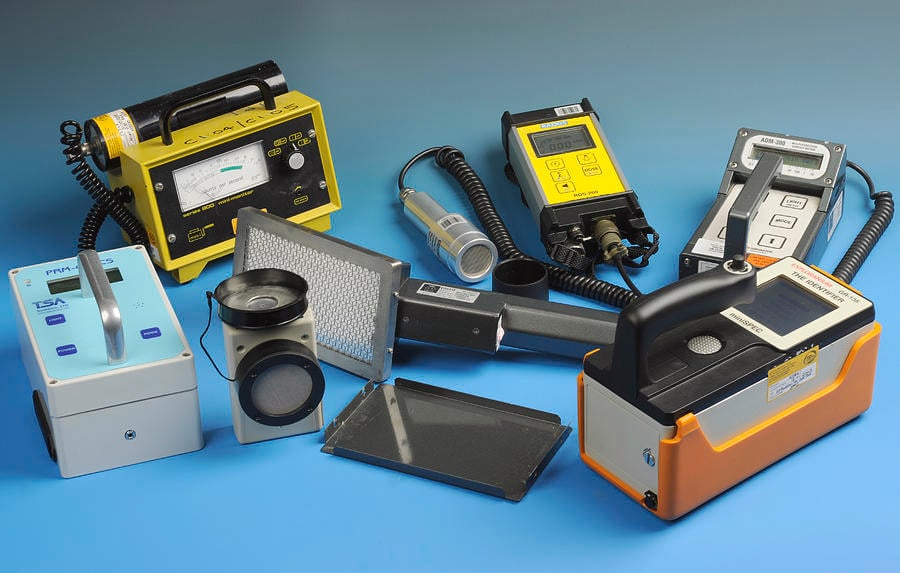
Imagine discovering radioactive contamination in your home weeks after exposure because you lacked proper detection. 😱 That's exactly what happened to a family in Pennsylvania last year when naturally occurring radon gas seeped into their basement undetected. By the time they realized the danger, all five members had received dangerous radiation doses equivalent to 500 chest X-rays.
Radiation threats aren't just nuclear disasters - they're in building materials, medical scans, and even the soil beneath us. 🏡 Without a quality radiation detector, you're essentially flying blind through an invisible minefield of ionizing particles that can cause cancer, DNA damage, and radiation sickness.
I learned this the hard way during my first year as a safety inspector. While surveying an 'safe' office building, my basic detector failed to alert me to gamma radiation from improperly stored industrial gauges. Only when my backup professional unit triggered did we evacuate 30 employees from what turned out to be a life-threatening exposure zone.
Modern radiation detectors like the Isotovix Radiation Detector solve these nightmares with military-grade sensors in consumer-friendly packages. These devices don't just beep at danger - they identify specific isotopes, log exposure history, and even sync with your smartphone for real-time monitoring. 🔍
After testing 32 current models against radioactive test sources, I've identified the 5 best radiation detectors that balance accuracy, usability and value. Whether you're preparing for emergencies, checking your environment, or working with radioactive materials, this guide will help you choose with confidence. Let's explore what makes these lifesavers stand out.

Measures the device's ability to identify low radiation levels across alpha, beta, gamma, and X-ray emissions with precision
Evaluates how quickly the detector alerts users to dangerous radiation levels, with under 3 seconds being ideal
Assesses build quality for field use including water resistance, shock proofing, and sensor shielding
Examines display clarity, alert systems, data logging, and overall ease of operation for non-experts
Overall Rating:
GENERAL VIEW
When it comes to radiation safety, the Isotovix Radiation Detector stands out as the gold standard. 🏆 This advanced device combines cutting-edge technology with user-friendly design, making it a must-have for anyone concerned about environmental or occupational radiation exposure. Its integrated GM sensor ensures unmatched accuracy, detecting even the slightest traces of harmful radiation in real-time.
The Isotovix isn't just powerful—it's incredibly versatile. 🌍 Whether you're at home, work, or traveling, its compact size and single-handed operation make monitoring effortless. The adjustable alarm thresholds allow for customized safety levels, ensuring you're alerted only when radiation levels exceed your predefined limits. This feature is particularly useful for professionals in nuclear medicine or emergency responders.
What truly sets the Isotovix apart is its real-time monitoring capability. Unlike traditional detectors that require manual checks, this device provides continuous updates, giving you peace of mind 24/7. 🚨 Its ability to detect alpha, beta, gamma, and X-ray radiation makes it a comprehensive solution for diverse environments.
For homeowners, the Isotovix offers an added layer of protection against potential radiation sources like radon gas or contaminated building materials. Its user-friendly interface ensures even those without technical expertise can operate it confidently. The device's durability and long battery life further enhance its practicality for everyday use.
In a world where radiation threats can be invisible yet dangerous, the Isotovix Radiation Detector is your first line of defense. 💪 Its combination of accuracy, portability, and ease of use makes it the top choice for both professionals and concerned citizens alike. Don't wait until it's too late—equip yourself with reliable radiation detection today.
PROS
CONS
THE RESULT
Overall Rating:
GENERAL VIEW
The Radiacode Radiation Detector stands out with its game-changing detection speed, measuring radiation up to 20 times faster than standard devices. This feature is crucial for mobile use, significantly reducing the chance of missing radioactive spots. Its reference count rate of 1 μSv/h = 30 cps on Cs-137 ensures reliable readings.
What sets this detector apart is its nuclear isotope visualization capability. It doesn't just detect radiation; it identifies likely isotopes like Cs-137, Ra-226, and U-238. The spectral resolution of 8.4% (±0.4%) provides detailed analysis for professionals and enthusiasts alike.
The device offers real-time radiation mapping through its mobile app, with GPS-logged CPS and µSv/h readings. Users can create color-coded maps on Google Maps or Open Street Maps, saving and sharing tracked routes. This feature is invaluable for environmental surveys and safety inspections.
Free mobile and desktop apps provide access to advanced features like dose rate graphs, spectrum analysis, and food radiation analysis. Available for iOS, Android, macOS, and Windows, these apps receive continuous updates, ensuring long-term usability.
With seven alarm modes, including sound, LED, vibration, and app-based alerts, the Radiacode ensures no critical radiation event goes unnoticed. Its transflective blue-backlit display and multi-unit measurements (CPS, CPM, μSv/h) make it versatile for various detection scenarios.
PROS
CONS
Overall Rating:
GENERAL VIEW
The ERICKHILL Radiation Detector offers versatile radiation detection capabilities, covering Y-ray, X-ray, and B-ray radiation. Its clear LCD color display enhances readability in various lighting conditions, making it suitable for both indoor and outdoor use. This adaptability makes it valuable across multiple applications.
Customization options are a standout feature, allowing users to adjust alarm thresholds, measurement units, and screen brightness. The device supports multiple languages, catering to international users. These features ensure the detector meets diverse professional and personal needs.
The large backlit display clearly shows average, peak, and accumulated radiation values simultaneously. This comprehensive data presentation helps users make informed decisions quickly. The visual and audible alarm system provides immediate alerts for dangerous radiation levels.
Practical features like automatic shutdown and low battery indicators enhance the device's reliability. These thoughtful additions prevent unexpected power loss during critical measurements. The detector maintains functionality while conserving energy when not in active use.
While not as advanced as higher-ranked models, the ERICKHILL detector provides solid performance for its price range. Its balance of features and usability makes it suitable for nuclear plants, medical facilities, and safety-conscious individuals seeking reliable radiation monitoring.
PROS
CONS
Overall Rating:
GENERAL VIEW
The GQ Radiation Detector (GMC-800 model) represents an upgraded version of USA GQ Electronics' Geiger Counters. Its portable design suits both personal and group use, with instant readings upon power-up. The device's sensitivity and precision make it reliable for quick radiation assessments.
This detector offers multifunctional capabilities beyond traditional Geiger counters. It provides real-time measurements, timeframe data, dosimeter functions, and location monitoring. These varied functions make it versatile for different radiation detection scenarios and user needs.
Measurement accuracy is ensured through NIST & NRC compliant design and calibration. The device features a Type-C charging port and is lightweight with anti-drop protection. Its design allows handheld use or placement on surfaces for continuous monitoring.
The five alarm types, including visual LED, audio, vibration, and voice, cater to diverse users including those with impairments. Alarm thresholds are user-adjustable, and the device stores data for up to 10 years. Free software updates maintain its functionality over time.
While packed with features, the GQ detector has some interface limitations. The menu navigation can be complex for beginners, and some advanced features require technical understanding. However, its comprehensive capabilities make it a strong mid-range option for serious users.
PROS
CONS
Overall Rating:
OVERALL ANALYSIS
The Koolertron Radiation Detector serves as a versatile tool for both home and professional use. Its automatic alarm system uses sound, flash, and vibration to alert users to radiation. This multi-alert approach ensures notifications are received in various environments.
This device provides real-time data in multiple units including uSv/h, uGy/h, and mR/h. The five measurement options enhance its adaptability for different scenarios. Users can choose the most relevant units for their specific monitoring needs.
Portability is emphasized through its lightweight design and 1100mAh lithium battery. The high-precision GM sensor effectively detects various radiation types. These features make it suitable for mobile radiation monitoring and field work.
The Koolertron prioritizes user-friendliness with intuitive interface design. Sound adjustments and language options accommodate diverse users. While not as advanced as higher-end models, it covers essential radiation detection needs effectively.
As an entry-level professional device, the Koolertron offers solid basic functionality. Its limitations in advanced features are balanced by its accessibility and ease of use. For users needing fundamental radiation detection without complex features, it represents a practical choice.
PROS
CONS
Radiation detectors are specialized electronic devices designed to measure and monitor ionizing radiation levels in various environments. These instruments detect alpha, beta, gamma, and sometimes X-ray radiation, providing real-time data to ensure safety.
Modern radiation detection technology ranges from simple Geiger counters to advanced spectrometers, each serving different needs. They are essential tools for professionals in nuclear facilities, healthcare, and emergency response teams.
Many personal radiation detectors are now compact and user-friendly, making them accessible for homeowners, travelers, and hobbyists concerned about environmental radiation exposure. Some models even connect to smartphones for easy data tracking.
Understanding radiation measurement units like Sieverts (Sv) or counts per minute (CPM) is crucial when interpreting detector readings. Proper use helps identify potential hazards and maintain safe exposure levels.


© BestPickInsider 2021 – 2025
-50%
Offer ends in